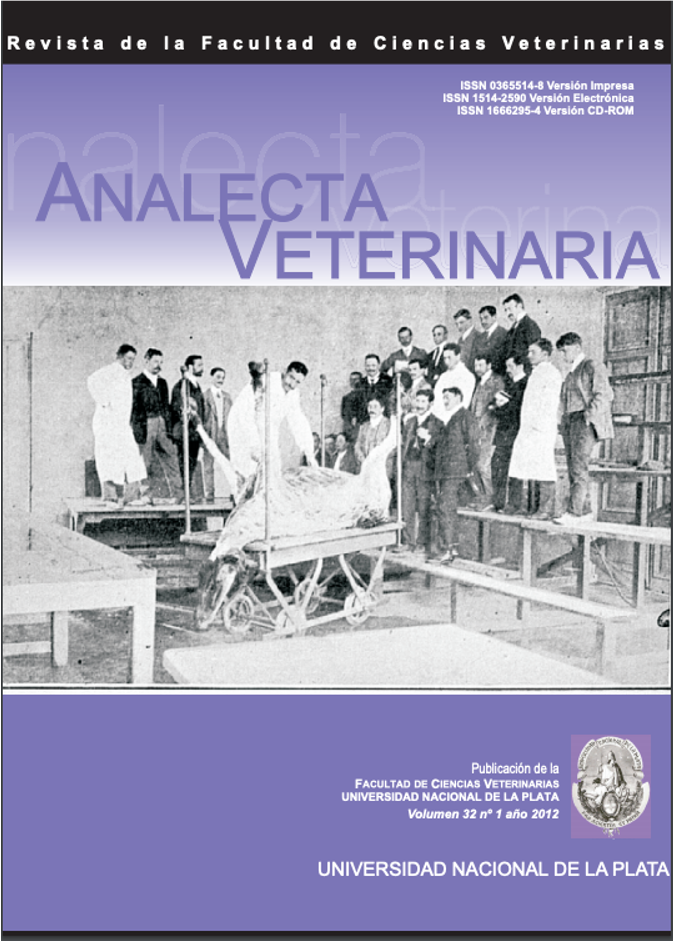Severed hemoparasitosis complicated in a thoroughbred horses from Venezuela
Palavras-chave:
Hemoparasites, Equine, PiroplasmosisResumo
Equine piroplasmosis (EP) is the disease caused by protozoan hemoparasites Babesia caballi and/or B. (Theileria equi). The aim of this study was to report of case of severed hemoparasitosis complicated in a Thoroughbred horse from Venezuela. The equine present acute abdominal pain in 24 hours and complicated post 48 hours and death in the 72 hours. Temperature oscillate 41;2°C. Icterus and hematury severed. We realized a multidisciplinary study clinical, laboratory, biochemistry, necropsy, histopathology. Hematies: 10.6 mm³, Hb: 16.4 g/dL, Hto: 48%, plaques 305mm³, Leucocites 4.7 x/mm³, Neutrophiles 47%, Lymphocytes 44%, Monocites 1%, Eosinophyles 7%. Total Protein 7,2g/dL, Albumine 2.8g/dL, globulin 4.4g/dL, glicemia 85mg/dL, urea 29mg/dL, creatinine 3.0 mg/dL. BT 3.07mg/dL, BD 0.33mg/dL, BI 2.74mg/dL, GOT 416UI/I,CK 183 UI/I, Na 136mmol/dL, K 3.0 mmol/dL, Cl 98 mmol/dL, fibrinogeno 300mg/dL. Giemsa staining of blood smears followed by careful microscopic examination can reveal the intraerythrocytic parasites in acute cases. B. caballi can appear pyriform-shaped and occurs in pairs whereas B. equi appears as four pyriform parasites in a Maltese-cross formation. On necropsy, were observed severed icterus oral and mucosa, xantomathosis of subcutaneous tissue. Poliserositis, ascitis, anasarca. In the abdominal cavity was observed massive hemoperitoneum severe, adhesive fibrinous peritonitis by diapedesis. Spleen with hemosiderosis severed. Peritonitis fibrinous adhesive in external surface of small intestine. Severe disseminate coagulate intravascular, hemolisis acute and bacteraemia, septicaemia. In conclusion were reported of case of severed hemoparasitosis complicated in a Thoroughbred horse from Venezuela.
Referências
Shuja A, Chihiro S, Misao O. Equine piroplasmosis. Journal of equine Science. 7: (4): 67-77, 1996.
Traub-Dargatz, J, Short M, Pelzel A, Norman T. Equine Piroplasmosis. AAEP Proceedings. Vol. 56:1, 2010.
George D. Imes; Ronald C. Neafie; Francis M. Chiricosta; Babesiosis (Piroplasmosis). Topics on the Pathology of Protozoan and Invasive Arthropod Diseases.June 1, 2011 Armed Forces Inst Of Pathology Washington Dc. 4. Aluja A., Constantino C. Technical of Necropsy in domestic animals. 2,ed. Mexico: Manual Moderno. 2002.
Banks W. Veterinary Applied Histology. 2, ed. México. Manual Moderno, 1996.
Jacobson LS. The South African form of severe and complicated canine babesiosis: clinical advances 1994-2004. Vet Parasitol 31; 138 (1-2):126-39, 2006. Epub 2006 Feb 24.
Russell Z. Edwards, Holly Moore, Bruce E. LeRoy, and Kenneth S. Latimer. Class of 2005 (Edwards) and Department of Pathology (Moore, LeRoy, Latimer) College of Veterinary Medicine, University of Georgia, Athens, GA 30602-7388.
Downloads
Publicado
Edição
Seção
Licença
Los autores/as conservan los derechos de autor y ceden a la revista el derecho de la primera publicación, con el trabajo registrado con la licencia de atribución de Creative Commons, que permite a terceros utilizar lo publicado siempre que mencionen la autoría del trabajo y a la primera publicación en esta revista.

Analecta Veterinaria por Facultad de Ciencias Veterinarias se distribuye bajo una Licencia Creative Commons Atribución-NoComercial-SinDerivar 4.0 Internacional.




























